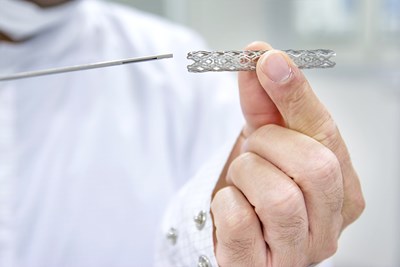As you age, plaque builds up in the walls of your arteries and increases your chances for heart problems. Plaque is made up of cholesterol, calcium, and fibrous tissue, and as it builds up, arteries harden and become narrower, which impairs normal blood flow to your heart. Restricted blood flow can lead to chest pain or discomfort—or more serious conditions, like heart attack and stroke. Clearly, treating an obstructed artery is of critical importance for your health.
Angioplasty is an alternative to bypass surgery, which is a major operation that also treats narrowed or blocked arteries. When possible, angioplasty is recommended, because of the advantages over bypass surgery. Not only is recovery time shorter due to a smaller incision, but the procedure can also be done while you are awake, which means general anesthesia is not needed.
Who is it for?
If you are experiencing symptoms of artery disease, such as chest pain or shortness of breath and have moderate to severe blockage in one or more of your blood vessels, your doctor may suggest an angioplasty procedure.
If you have any of the following, however, you are not a good candidate for this type of surgery:
- Plaque deposits that are hard
- Blockages containing blood clots or a significant amount of calcium
- Extensive or long blockages
- Continuous blood vessel spasms
- Buildup that cannot be passed with a catheter
How is it done?
Angioplasty begins with the insertion a catheter—a long, narrow tube—through a small incision in your thigh or arm. Your specialist will guide the catheter through your blood vessels until it reaches the narrowed part of the artery in your heart. A tiny balloon, which is attached to the tip of the catheter, is then inflated with air. The inflated balloon flattens the plaque and widens the artery. In most cases, a wire tube, known as a stent, remains inside the treated artery in order to hold it open.
You will be awake for the operation but may be given something to help you relax. However, an angioplasty is generally not painful. Because your arteries do not have nerve endings, you will not feel the catheter as it moves through your vessels, but it is common to experience discomfort in your chest when the balloon is inflated. One of the advantages of being awake is that you can tell your doctor if you start to experience unpleasant symptoms.
What are the risks?
Serious complications are rare, but can happen. Here are some of the risks you should be aware of:
- Bleeding or bruising where the catheter was inserted
- A torn or weakened blood vessel
- Allergic reaction to contrast dye
- A blood clot in the treated artery
- Kidney problems
- Dissection, or damage to the lining of the artery
- Embolization, or the movement of plaque from one area of the artery to another
- Restenosis, or excess tissue growth in the affected artery
Complications are more likely to occur if:
- You are over the age of 65
- You have chronic kidney disease
- You have a history of heart disease and blockages



